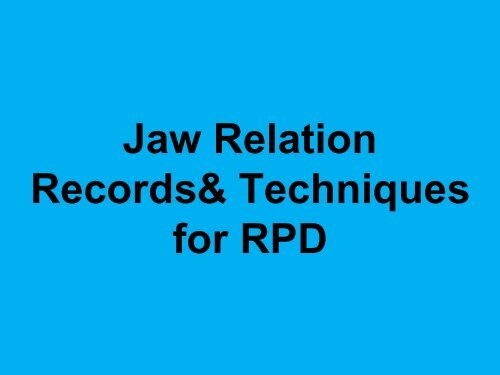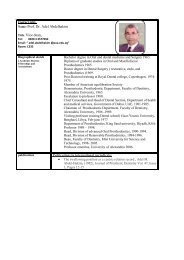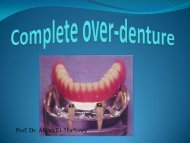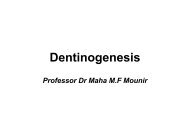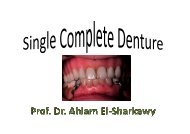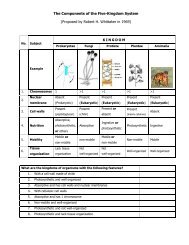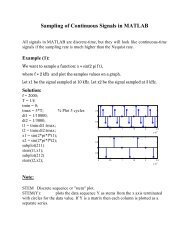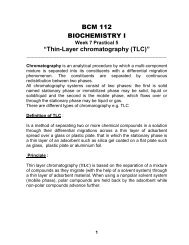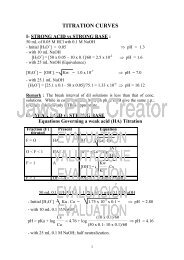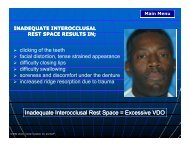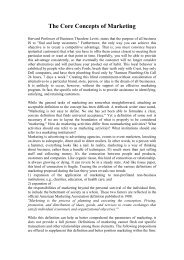Methods of Recording Jaw relations
Methods of Recording Jaw relations
Methods of Recording Jaw relations
You also want an ePaper? Increase the reach of your titles
YUMPU automatically turns print PDFs into web optimized ePapers that Google loves.
<strong>Jaw</strong> Relation<br />
Records& Techniques<br />
for RPD
OBJECTIVES<br />
1. Arrangement <strong>of</strong> the artificial teeth<br />
2. To distribute functional forces<br />
between the remaining natural<br />
teeth & the residual ridge<br />
(harmonious occlusion)
CLINICAL APPROACH<br />
1. There are sufficient teeth present in<br />
both jaws to indicate inter-cuspal or tooth<br />
position<br />
2. There are insufficient teeth present to<br />
indicate inter-cuspal or tooth position<br />
3. One jaw is edentulous and the other is to<br />
be restored by RPD
<strong>Methods</strong> <strong>of</strong> <strong>Recording</strong> <strong>Jaw</strong> <strong>relations</strong><br />
Direct Apposition <strong>of</strong> Casts<br />
(Hand Articulation)<br />
This method can only be used<br />
when sufficient opposing<br />
teeth remain in contact to<br />
make the existing jaw<br />
<strong>relations</strong>hip obvious.
<strong>Methods</strong> <strong>of</strong> <strong>Recording</strong> <strong>Jaw</strong> <strong>relations</strong><br />
Direct Apposition <strong>of</strong> Casts<br />
(Hand Articulation)<br />
The occluded casts are secured together with the<br />
help <strong>of</strong> wooden sticks and sticky wax and<br />
mounted arbitrary on an articulator.<br />
A face-bow record is not indicated.<br />
A clinical appointment is saved by using this method.
<strong>Methods</strong> <strong>of</strong> <strong>Recording</strong> <strong>Jaw</strong> <strong>relations</strong><br />
• The remaining dentition does not provide<br />
sufficient occlusion<br />
• It is not permit occluding the casts by<br />
hands.<br />
• There are Two Possibilities:<br />
Inter-occlusal Record<br />
(Wax, Zinc oxide)<br />
Kennedy Class III<br />
Occlusal Rimes<br />
Distal extension<br />
Long bounded areas
<strong>Methods</strong> <strong>of</strong> <strong>Recording</strong> <strong>Jaw</strong> <strong>relations</strong><br />
Inter-occlusal Record<br />
Bilateral Contact <strong>of</strong> Posterior Teeth at<br />
Inter-cuspal position (ICP).
<strong>Methods</strong> <strong>of</strong> <strong>Recording</strong> <strong>Jaw</strong> <strong>relations</strong><br />
Occlusal Rimes<br />
1. The framework with the attached record block is<br />
first tried in the mouth for reconfirming the fit <strong>of</strong><br />
framework.<br />
2. An auto-polymerizing acrylic resin<br />
base is usually attached to the<br />
framework saddle areas<br />
3. A wax occlusion rim is then placed<br />
over the resin base, while<br />
considering the width and<br />
height dimensions <strong>of</strong> the natural<br />
missing teeth.
<strong>Methods</strong> <strong>of</strong> <strong>Recording</strong> <strong>Jaw</strong> <strong>relations</strong><br />
Adjusting the Occlusion rim<br />
Adjusting the Occlusal Plane following<br />
the remaining natural teeth
<strong>Methods</strong> <strong>of</strong> <strong>Recording</strong> <strong>Jaw</strong> <strong>relations</strong><br />
Adjusting the Occlusion rim
The recording medium (wax or ZnO<br />
paste) is then placed on the<br />
mandibular wax rims the patient is<br />
then guided in the desired C.O or<br />
C.R position.
<strong>Methods</strong> <strong>of</strong> <strong>Recording</strong> <strong>Jaw</strong> <strong>relations</strong><br />
• One jaw is edentulous and the other is to<br />
be restored by RPD<br />
• Vertical <strong>Jaw</strong> Relations:<br />
Rest Vertical Dimension ‘RVD’<br />
• Horizontal <strong>Jaw</strong> Relations:<br />
Occlusion Vertical Dimension ‘OVD’<br />
Centric Relation<br />
Centric Occlusion<br />
Eccentric Relations<br />
Protrusive relation<br />
Lt & Rt Lateral <strong>relations</strong>
<strong>Methods</strong> <strong>of</strong> <strong>Recording</strong> <strong>Jaw</strong> <strong>relations</strong><br />
. One <strong>of</strong> the arches is edentulous.
Vertical <strong>Jaw</strong> Relations<br />
Rest Vertical Dimension ‘RVD’<br />
Occlusion Vertical Dimension ‘OVD’<br />
Inter-occlusal Distance / Free<br />
way Space
Horizontal <strong>Jaw</strong> Relation<br />
Centric Relation<br />
‘the most retruded position <strong>of</strong> the mandible<br />
to maxilla at an established OVD’.<br />
It is a bone to bone relation
Horizontal <strong>Jaw</strong> Relation<br />
Centric Occlusion<br />
‘the relation <strong>of</strong> the mandible to maxilla in<br />
the maximum intercuspation <strong>of</strong> the teeth’.<br />
It is a tooth-tooth relation - a position <strong>of</strong> habitual<br />
closure.
Horizontal <strong>Jaw</strong> Relation<br />
What to Record – C.R or C.O?<br />
In more than 90% <strong>of</strong> people, C.O is 0.1 - 2mm in<br />
front <strong>of</strong> the CR.
Horizontal <strong>Jaw</strong> Relation<br />
What to Record – C.R or C.O ?<br />
Centric Occlusion should be recorded<br />
whenever a patient requiring a partial denture has<br />
cusps on remaining natural teeth that can guide<br />
the mandible back to this position,
Horizontal <strong>Jaw</strong> Relation<br />
What to Record – C.R or C.O<br />
C.R should be recorded, e.g., for distal extension<br />
RPD, or when the opposing arch is edentulous.
The registration obtained by means <strong>of</strong> a<br />
face-bow is called a<br />
“face-bow record”.
Obtaining & Transferring the Face-bow Record<br />
Orientation <strong>of</strong> face-bow to articulator.
Functional- Generated Path<br />
Method(Dynamic Method)
STEP BY STEP PROCEDURE FOR<br />
REGISTRING OCCLUSAL PATHWAY<br />
After the framework has been adjust to fit the mouth,<br />
the technique for registration <strong>of</strong> occlusal pathways<br />
is as follow:<br />
1. Support the wax occlusion rim by a denture base<br />
having as same degree <strong>of</strong> accuracy and stability as<br />
the finished denture base.<br />
The wax used for the occlusion rim should be hard<br />
enough to support biting stress and should be tough<br />
enough to resist fracture.( purple hard inlay wax)<br />
2. Inform the patient that the occlusal rim must be worn<br />
for 24hours or longer. It should be worn constantly,<br />
including night-time, excepts for removal during<br />
meal. By wearing and biting into a hard occlusal rim ,<br />
record is made <strong>of</strong> all extent <strong>of</strong> jaw movement
STEP BY STEP PROCEDURE FOR<br />
REGISTRING OCCLUSAL PATHWAY<br />
3. After 24 hours the occlusal surface <strong>of</strong> the wax<br />
rim should show gloss generated pathways.<br />
Which indicate functional contact with opposing<br />
teeth in all extreme <strong>of</strong> movements.<br />
Any are <strong>of</strong> deficient are add this time.<br />
4. These generated pathways are reproduced by<br />
stone. Each grove in wax representing pathway<br />
<strong>of</strong> a cusp becomes a ridge <strong>of</strong> stone<br />
5. Artificial teeth are arranged on the RPD<br />
framework to inter-cuspate with the pathways <strong>of</strong><br />
their antagonists
This method eliminate the need <strong>of</strong> face bow transfer<br />
Bec. Patient himself, is the best articulator for<br />
developing occlusion.
GUIDELINES FOR CHOICE OF OCCLUSAL<br />
CONCEPT FOR PARTIALLY EDENTULOUS<br />
PATIENTS<br />
Maxillary arch Mandibular arch Occlusal concept<br />
1 Fully edentulous<br />
restored by CD<br />
Kennedy Class I<br />
restored by RPD<br />
2 Fully dentate Kennedy Class I<br />
restored by RPD<br />
Balanced occlusion<br />
(working, Balancing,<br />
protrusive)<br />
Working side contact<br />
3 Kennedy Class I<br />
restored by RPD<br />
Fully dentate<br />
Working & Balancing<br />
side contact<br />
4 Kennedy Class II Fully dentate Working side contact<br />
5 Fully dentate Kennedy Class III Working side contact<br />
6 Kennedy Class III Kennedy Class III Working side contact<br />
7 Kennedy Class IV Fully dentate Contact in centric<br />
No eccentric contact


